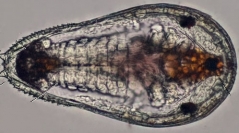

 European Journal of Taxonomy
929 (1) - Pages 1-90
European Journal of Taxonomy
929 (1) - Pages 1-90The enigmatic ‘y-larvae’ (Thecostraca: Facetotecta) are microscopic marine planktonic crustaceans that were discovered more than a century ago, yet to this day their adults remain unknown. Despite occurring locally in large diversities, and therefore presumably being of ecological importance, only 17 species have been described globally, rendering it practically impossible to identify any y-larval specimen from any locality. The fact that species have been based on different life stages (nauplii and/or cyprids) further hampers identification. Y-larvae include many forms with planktotrophic (feeding) nauplii and even more with lecithotrophic (non-feeding) nauplii. At one coral-reef locality on the shore of Sesoko Island (Okinawa, Japan), extensive fieldwork in 2018 and 2019 confirmed an enormous taxonomic diversity of y-larvae there. Here, we present morphological diagnoses and an identification key for 34 lecithotrophic y-naupliar types (or morphospecies), which will correspond minimally to the same number of species when described. As a temporary measure, all are referred to by alphabetical parataxonomic designations, except for three that have been formally described already within the genus Hansenocaris Itô, 1985. To this should be added an additional 7–9 planktotrophic y-naupliar morphospecies, which are only treated briefly. Most often, y-larval taxonomy has been based on the cyprid stage, but the large morphological diversity of y-nauplii suggests that nauplii are at least as important for taxonomy. Lecithotrophic y-nauplii display a multitude of body shapes, the form-evolution of which is discussed here with reference to a recent molecular phylogeny of Facetotecta partly based on material from the same site. An indirect estimate of the relative abundances of all 34 lecithotrophic y-naupliar morphospecies is presented, based on laboratory-reared final-instar specimens. This treatment is intended as a step towards a proper taxonomy and a revised classification of Facetotecta, which will involve detailed descriptions of both nauplii and cyprids. Until such work progresses, the present overview of the y-naupliar fauna of a single Okinawan locality known to be a hotspot of y-larval diversity is offered as a baseline for further surveys of Facetotecta elsewhere in the Indo-West Pacific and beyond.
Coral-reef plankton, nauplius, laboratory rearing, parataxonomy, dichotomous key, microphotography, SEM